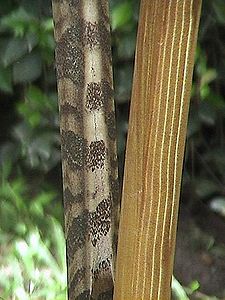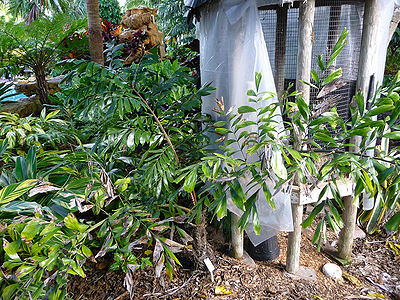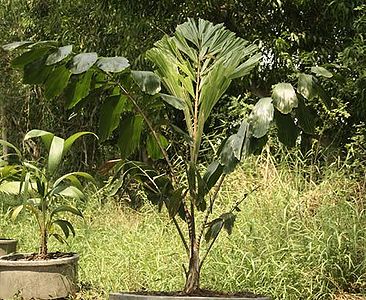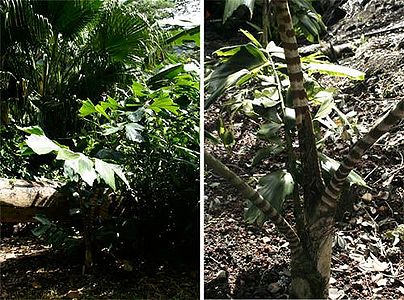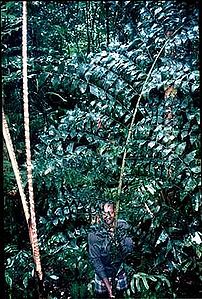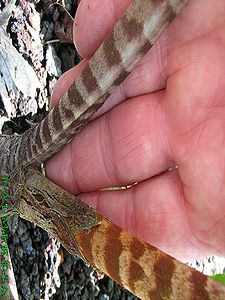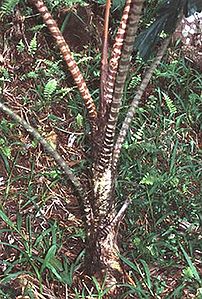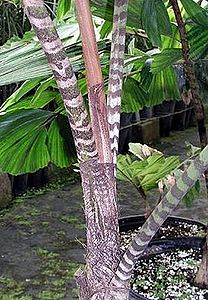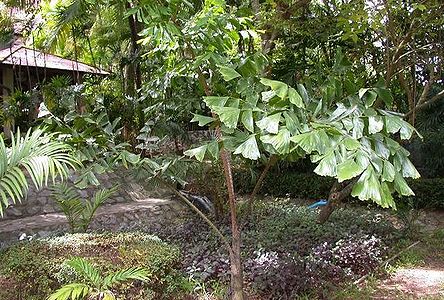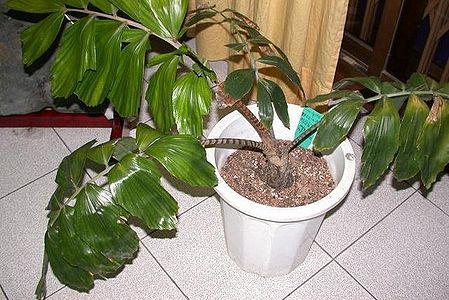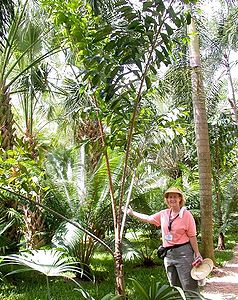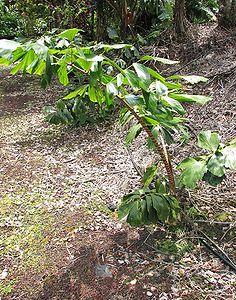Caryota zebrina
<google>CH02</google>
| Caryota (kair-ee-OH-tuh) zebrina (zih-BREE-nuh) | |||||||
|---|---|---|---|---|---|---|---|
 New Caledonia, photo by Ben, edric. | |||||||
| Scientific Classification | |||||||
| |||||||
| Synonyms | |||||||
|
| |||||||
| Native Continent | |||||||
|
| |||||||
| Morphology | |||||||
| |||||||
| Culture | |||||||
|
| |||||||
| Survivability index | |||||||
|
| |||||||
| Common names | |||||||
|
| |||||||
Contents
Habitat and Distribution
Torricelli Mountains, West Sepik Provence, Papua New Guinea. In mountain forest at 850-1500 m.
Description
Trunk type: Solitary. Hight: To 50 feet. Leaf detail: Pinnately compound, bipinnate, to 5 meters, (16 feet), Zebra striped petiole,thick, leathery, blackish/green leaflets are at differing angles, and in irregular clusters along the frond, giving the leaf a generally disorganised appearance. Also unusual in this palm caries only 3 to 4 fronds, at a time. Editing by edric.
Solitary monoecious hapaxanthic palm; stems 6-16 m tall, about 20-40 cm in diam., bare near the base, distally covered with sheaths; internodes 30-40 cm long, nodal scars about 2 cm wide, internode surface cracking longitudinally and covered with a thick layer of dirty brown tomentum. Leaves 5-7 m long, about 1.5 m wide, young leaves pale green, older leaves dirty blackish green; sheath 1-2 m long, about 15 cm wide, markedly fibrous along margins, in mature leaves covered in dull brown tomentum, in juveniles strikingly tiger-striped with bands of pale and dark tomentum; ligule to about 25-60 cm long, covered in a dense layer of dirty brown tomentum, the ligule and sheath margins disintegrating into thin long black fibres; petiole about 1-2 m long, 2-6 x 2-3 cm in cross section, in young leaves tiger-striped with bands of pale and dark indumentum as the sheath, in older leaves dark olive green; rachis to 5 m long, to 20 x 28 mm in section in mid-leaf, adaxially with a strong flange about 8 x 5 mm, abaxially convex, covered in dense caduceus dark brown tomentum; primary pinnae about 20 on each side if the rachis, up to ca. 20 cm apafi, the basal primary pinnae about 80 cm long, the mid-leaf primary pinnae ca. 150 cm long, the distal to 100 cm long; secondary pinnae drying pale coloured, about 7-11 on each side of the secondary rachis, up to about 26 x 7 cm, irregularly wedge-shaped, leathery, veins radiating from the base, adaxially glabrous, abaxially with broad bands of caducous brown scales; transverse veinlets obscure. Inflorescences 1-2.5 m long, branching to 3 orders (always?); peduncle to 30 x 40 mm in diam., the surface densely covered in dull brown tomentum; distal bracts tubular, circumscissile and leaving a low collar, splitting distally to form a triangular limb to 22 x 12 cm, edged with dark brown fibers and covered in caducous brown tomentum; basal first order branches with a conspicuous pulvinus to about 5 cm wide; rachillae of various lengths, the longest to at least 1 m, 3-4 mm in diam., covered in dark brown indumentum; triads about 8-10 mm distant; rachilla bracts low, crescentic. Staminate flower at anthesis about L4 x 7 mm; sepals 3, dark green, strongly imbricate, irregularly gibbous, broad, rounded, entire or emarginate, the outermost 5 x 8 mm, the middle 5 x 7 mm, the innermost 5 x 7 mm, the three slightly connate basally; petals 3, free to the base, 12.0 x 4.5 mm, glabrous, smooth, almost spathulate with rounded triangular tips; stamens about 28, filaments 3.0 x 0.3 mm, anthers orange 5-7 x 0.6 mm, connective dark tanniniferoris, projecting beyond the anthers as a short bifid tip to 0.5 mm; pollen monosulcate, exine semitectate with anastomosed clavae forming irregular islets of tectum (Harley, pers. comm.); pistillode absent. Pistillate flower in bud (van Royen & Sleumer 6129) superficially similar to staminate flower but narrower, about 10.0 x 3.5 mm except at base where 6 mm wide; sepals 3, rounded, broadly imbricate, irregularly gibbous, the outer 4 x 7 mm, the middle 4 x 7 mm, the innermost 3.5 x 6.0 mm; petals 3, free in bud, 9.0 x 2.8 mm; staminodes 3 , antesepalous, filaments to 4 x 0.3 mm; gynoecium conical, 2 x 3 mm with 2 stigmas to 1.2 x 0.5 mm, ovules 2. Pistillate flower (Maturbongs MM586) post anthesin with petals basally connate for 2 mm with narrow triangular lobes to 7 x 5 mm; ovary 6 x 6 mm with 2 ovules. Fruit ripening white and then red, globose to depressed globose, to 15 x 25 mm, with apical stigmatic remains; epicarp minutely papillate. Seeds 2, hemispherical, about 72 x 15 x 8 mm, surface smooth, with scattered veins, with basal corky mass; endosperm homogenous; embryo lateral. (J. Dransfield, G.G. Hambali, R.A. Maturbongs and C.D.Heatubun. 2000)/Palmweb.
Caryota zebrina shares several features with Caryota ophiopellis Dowe that are unusual in the genus; these include homogeneous endosperm, inflorescences branched to more than one order, pistillate flowers with large petals similar to those of the staminate flower, unusual pollen and, of course, the extraordinary tiger-striped petioles. At first we thought they might be one and the same. However, there are several clear differences between them. Caryota ophiopellis was described originally as having a tear-drop shaped seed but this has been shown more recently to be anomalous, and the seed (of a single-seeded fruit) is rounded, lacking the depression found in C. zebrina. There are also subtle differences in leaf texture between the two, with C. zebrina having thicker and shinier leaflets than those of C. ophiopellis. The pollen grains of the two species are very distinctive but different. Two different intectate pollen types were until recently known in Caryota - pollen with small, regular clavae (club-like processes) and pollen with spine-like processes, and, in fact, pollen appears to be of importance in the evolution of the genus as it clearly helps to define two major evolutionary lines (Hahn & Sytsma 1999). Caryota zebrine has clavae but they are anastomosed to the extent that the whole grain becomes irregularly semitectate, while in C. ophiopellis the clavae are separate or pressed together in smaller or larger groups, often in a loose reticulate pattern and occasionally are anastomosed. Pollen of the two species will be the subject of a more detailed study. (Harley, in prep.). J. Dransfield, G.G. Hambali, R.A. Maturbongs and C.D.Heatubun. 2000)/Palmweb.
This is the second species of Caryota to be recognized in New Guinea, the other being C. rumphiana. The latter species is instantly recognizable by larger stature, its inflorescences branched to one order only and its seeds with the ruminate endosperm typical of the genus. Furthermore, juveniles of C. zebrina carry the distinct and beautiful banding of different shades of gray and brown indumentum that makes the species such a desirable ornamental. J. Dransfield, G.G. Hambali, R.A. Maturbongs and C.D.Heatubun. 2000)/Palmweb.
In the Cyclops Mountains, Caryota zebrina appears to be confined to the western part, where it occurs at elevations of 850-1500 m above sea level. Its absence from the eastern part of the mountains is probably related to the fact that this part of the range is not so high. The palm may well occur at elevations higher than 1500 m. Below 850 m elevation scattered seedlings can be found, sometimes intermingled with those of Caryota rumphiana, from which C. zebrina can be distinguished by the presence of three stripes of brown indumentum on the undersurface of each leaflet, the more leathery texture and the fact that the two leaflets of the eophylls are much more widely divergent. Seeds have been discovered in the droppings of cassowaries, so these majestic birds may be responsible for dispersal. In the wild, the zebra striping of the petioles becomes less and less conspicuous as the plants become older. In cultivation in Bogor, there is considerable variation in the intensity of striping from one individual to the next. (J. Dransfield, G.G. Hambali, R.A. Maturbongs and C.D.Heatubun. 2000)/Palmweb.
Culture
Requirements: Near full shade, when young, partial shade when mature, consistently moist soil, well drained position. Special note: This species is monocarpic. This palm is very slow, and very difficult in cultivation, and to be considered a strictly tropical species. Sheltered, shady position in moist, but well drained soil. Although it comes from Papua New Guinea, it is found quite high in the mountains, so it is probably quite cold tolerant. It is however, a very slow grower. Editing by edric.
Curiosities
Special note: This is the only Caryota, that is not bipinnate.
External Links
References
Phonetic spelling of Latin names by edric.
Special thanks to Geoff Stein, (Palmbob) for his hundreds of photos, edric.
Special thanks to palmweb.org, Dr. John Dransfield, Dr. Bill Baker & team, for their volumes of information and photos, edric.
Glossary of Palm Terms; Based on the glossary in Dransfield, J., N.W. Uhl, C.B. Asmussen-Lange, W.J. Baker, M.M. Harley & C.E. Lewis. 2008. Genera Palmarum - Evolution and Classification of the Palms. Royal Botanic Gardens, Kew. All images copyright of the artists and photographers (see images for credits).
Dransfield, J. , Hambali, G.G. , Maturbongs, R.A.C.D.Heatubun. 2000. Caryota zebrina.
- IMAGE GALLERY
Many Special Thanks to Ed Vaile for his long hours of tireless editing and numerous contributions.









